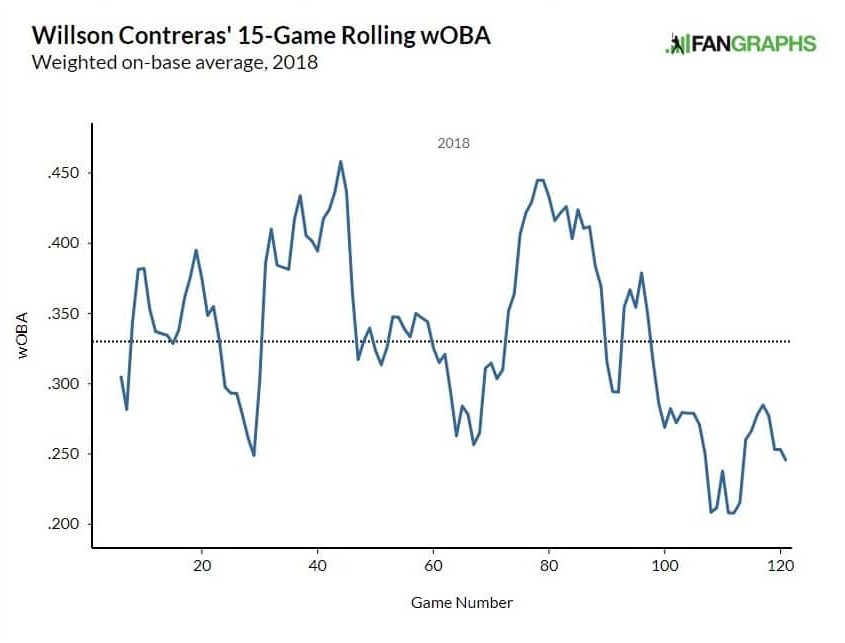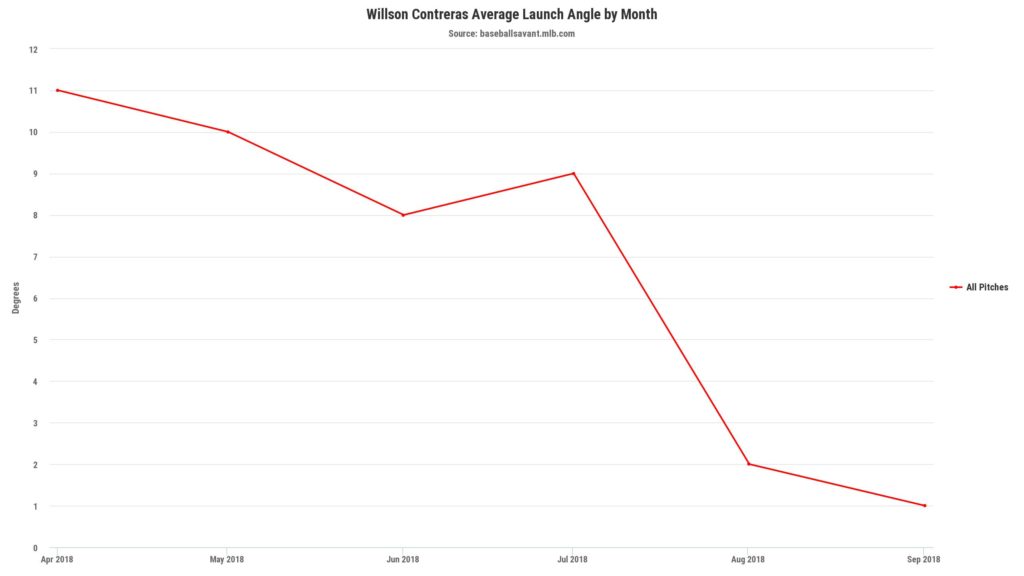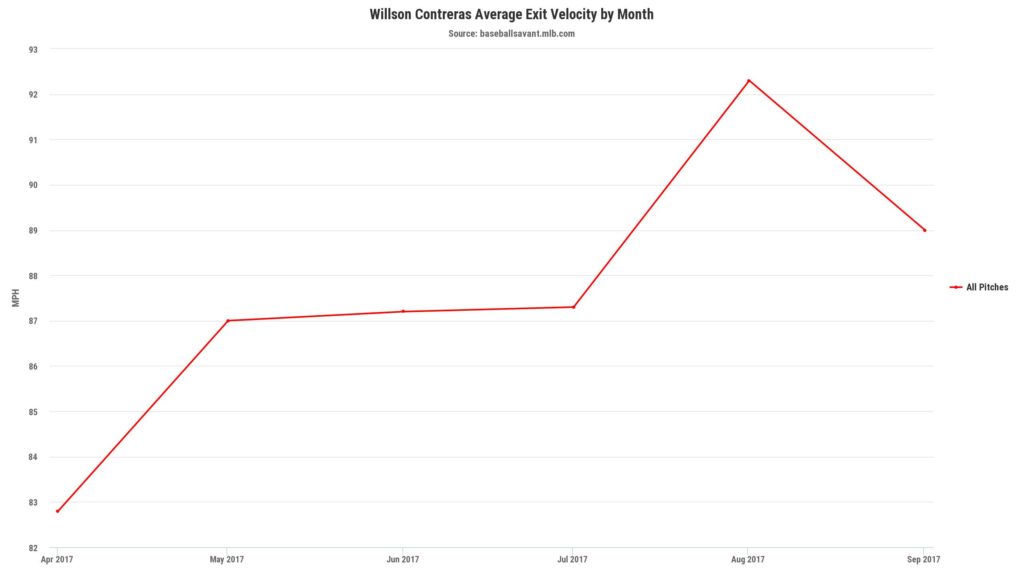
Willson Contreras Appears to Have Bonked as Offensive Production Craters
By pretty much every measure, Willson Contreras is an above-average offensive performer. His season and career numbers are all very solid, particularly when compared to his peers behind the plate. But it’s impossible for anyone who’s watched the hard-charging backstop recently to come away believing this is the same player who was garnering MVP chatter heading into the season.
Now before I go further, I want to make very clear that this is not a hit piece in any way, shape, or form. I am drawing no conclusions as to Contreras’s long-term value, nor am indicting his past performance. My purpose here is to shine a light on his recent production, which has been far from exemplary.
As CI’s Jeff Burdick pointed out in August, Contreras getting the lion’s share of innings behind the plate may be costing him at it. If we’re being really honest, catching over 50 more innings than anyone else in MLB is also taking its toll on his defense. He’s never been a great framer, but it’s painfully evident from the recent spate of dropped balls and failure to block pitches that Contreras is gassed back there.
This isn’t a question of effort, but of ability. At times it appears as though Contreras is experiencing what distance runners refer to as bonking, though it may seem unfair to assign such an acute affliction to what is probably more general fatigue. Then again, it’s more than fair to use the familiar trope of the baseball season as a marathon, in which case we can go back to the bonk.
While a review of his 15-game rolling wOBA (or weighted on-base average, a catch-all offensive measurement) reveals the expected peaks and valleys, it’s easily apparent that this current valley is deeper and more prolonged.

And while drop-off would be natural after Contreras posted a .347 BABIP (league average is around .300 and his career average is .326), these results are more than mere regression. Take a look below at his 15-game rolling soft-contact percentage, which is essentially an inverse image of that above.

The trends continue when we look at Contreras’s average exit velocity and launch angle by month, both of which are heading downward at frighteningly steep rates. According to Baseball Savant, his 81.7 mph average exit velo for August — the lowest month of his career — should produce batting average and wOBA numbers right around .230 or so. Combine that with a falling launch angle and you get the image of a flower wilting in the summer sun.


Now I know some of you may be thinking this is no big deal and that it’s bound to happen late in the season. After all, they don’t call them dog days for nothing. To that end, I offer up the following charts of Contreras’s exit velocity and launch angle last season…


As you can see, his EV actually improved over the course of last season while his launch angle fluctuated but remained along the same average line. So what was different?
Most notably, Contreras jacked up his hammy and missed most of August and part of September as a result. Not that you want to give a guy a break for that reason, but it certainly left him well rested down the stretch run and into the postseason. Joe Maddon was also able to rotate his starting catcher into other spots on the diamond prior to the injury, allowing Contreras to log 54 innings elsewhere in the field.
Not only has Contreras been healthy this season, but the confluence of a glut of position players and a dearth of competent backup catchers has resulted in him going way past his career high innings caught. He’s at 985.2 innings as of post time, which is almost 165 more than he’s ever caught in a season before. That’s important when we overlay his playing time with the charts shown above.
Based on both actual results and the eye test, the wheels have really started to fall off over the last month or so. That last solid peak in the wOBA graph came on August 5, at which point Contreras would have been right around 800 innings at catcher. Given his career-high was 821.1, which he set last season and with a month-long break in there, it’s understandable that getting around that mark could result in fatigue and flagging results.
Sure enough, we see a startling disparity in offensive production over the last month compared to the rest of the season up to that point. As of August 5 (396 plate appearances), Contreras was slashing .281/.371/.450 with a 122 wRC+ and .355 wOBA. For the sake of reference, the average MLB catcher is posting a .233/.305/.372 slash line with a wRC+ of 83 and a .296 wOBA. WillCo was basically 40 percent than average.
In the month since (91 PAs), Contreras is slashing .163/.264/.200 with a .222 wOBA and a 33 wRC+, which means he’s basically 50 percent worse than average. His soft contact has gone from 20.6 percent in the first sample to 31.6 in the second and his hard contact has dropped from 32.1 to 14 percent. And that .347 BABIP has fallen to .228 over the last month.
We often use extreme BABIP results (those that stray too far from .300) to indicate good or bad luck. But common sense and millions of data points will tell us that hitting the ball hard and keeping it off the ground will yield better results. And as we see above, Contreras is almost incapable of producing hits right now.
The only moderately positive results over the last few weeks have come because his contact is so bad it’s good, since dribblers and swinging bunts can result in infield hits and RBI groundouts. But, like, is that really something to be pleased about? No, it’s not. Admittedly, neither is the prospect of seeing a parade of backups led by Victor Caratini, Taylor Davis, or light-hitting Bobby Wilson, who was recently acquired from the Twins for Chris Gimenez.
With the Cubs maintaining their division lead and their magic number shrinking each day, though, the lesser-of-two-evils pendulum swings ever in favor of more rest for Contreras. So while the possibility exists that he could suddenly turn things back on after shooting past 1,000 innings, anyone who’s ever bonked will tell you that’s highly unlikely.
As such, it is incumbent upon Maddon to carve out more rest for his catcher in order that these ugly hitting trends can be reversed by October. Because that’s what this is about right now. It doesn’t matter that the backups offer less potential in theory, since Contreras is doing little to help the Cubs win right now. If he can recuperate both physically and mentally over the next three weeks, however, he can still have a huge impact in the playoffs.
In closing, I’ll reiterate that this is not some sort of half-assed op-ed about why Contreras needs to go. Far from it. But while he still possesses tremendous potential for production on both at and behind the plate, his play of late has been far below replacement level and it’s obvious that something needs to change. Soon.

